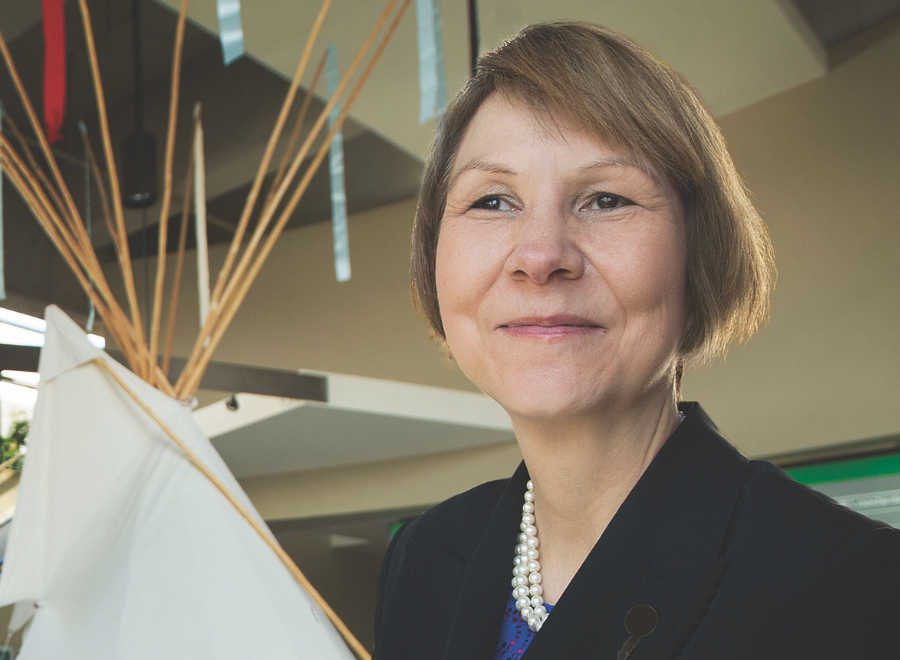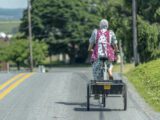The offices are small with decor that is a mix of Indigenous art gallery and parent’s fridge. A rawhide drum and Aboriginal prints jostle for wall space with crayon drawings by kids from places such as Attawapiskat, Ont., and New Delhi, India. But the open-concept design — three cluttered desks and three cheerful workers — lends warmth and expansiveness to the workplace of the First Nations Child and Family Caring Society.
A hand-stitched quilt hangs on the wall in the adjoining lunchroom. It is here that I am offered a seat, peanut butter cookies from a Ziploc container and water, which arrives in a bright plastic child’s cup. “I hope that’s okay?” Tammy Morgan asks. Morgan is Cindy Blackstock’s executive assistant.
You may unsubscribe from any of our newsletters at any time.
It’s a Thursday in September and Blackstock has just flown in from Edmonton, where she met with Indigenous agencies. She’ll celebrate her 50th birthday in Ottawa, then fly to Winnipeg and Saskatoon for more meetings and to present at two conferences. This is routine travel for Blackstock.
“You can’t do this work without learning from people,” she explains shortly after taking a seat in the lunchroom chair next to mine and offering me another cookie. Since 2003, Blackstock has served as executive director of the Caring Society, a bare-bones lobby group based in Ottawa. The kids and families for whom she advocates live in communities across Canada.
Charlene Bearhead, the national co-ordinator of an arts group that helps students explore the legacy of Indian residential schools, says a childlike thirst for justice has Blackstock banking 150,000 miles in the air each year.
“When children are young, they are honest and they don’t let anybody tell them otherwise. And she has got that same integrity. Children are fearless when it comes to speaking the truth. And Cindy has that courage still as an adult,” Bearhead says.
It is this courage to speak the truth that has made Blackstock a major figure in the fight for First Nations rights, the pre-eminent advocate for Indigenous children — and even the target of illegal government surveillance.
Some media reports have described Blackstock as “quiet spoken,” but you wonder if journalists haven’t exaggerated the quality to lend tension to their stories. Her tone is measured, her arguments are reasoned and she likes facts — such as the 22 percent less the federal government spends on child welfare services to Indigenous kids as compared to provincial spending for non-Indigenous kids.
She isn’t your typical firebrand, but she doesn’t pull punches either. “Today, there are three times the number of First Nations in child welfare care than there were at the height of residential schools,” she wrote in a 2008 letter to the Ottawa Citizen. “The government spied on me without a warrant,” she wrote in the Toronto Star. “The Canadian government is on trial for racial discrimination of First Nations’ kids,” she told the Vancouver Sun in 2013.
Blackstock has a name for her approach to standing up for First Nations kids: Mosquito Advocacy. She deploys cute mnemonics such as “create the buzz” (have an infectious message), “swarm” (bring friends), “avoid the swat” (use more than one approach), and “the sting” (have a clear target). They translate well to PowerPoint slides.
Her Caring Society’s many campaigns have been noticed, even if they haven’t always yielded results. Shannen’s Dream pushes for “safe and comfy schools” for communities like Attawapiskat. Jordan’s Principle calls on the various levels of government to address the medical needs of patients before squabbling over jurisdiction.
More recently, I Am a Witness invites ordinary Canadians to follow a human rights complaint her Caring Society launched in 2007 together with the Assembly of First Nations (AFN). The complaint alleges the federal government provides flawed and inequitable childcare services to First Nations foster children on reserve. (More on that later.)
The moral purpose of the campaigns makes Blackstock a popular speaker, as she was at the United Church General Council in 2012, where she spoke on residential schools and First Nations children today — one of more than 20 keynote presentations she would make that year. She inspires people. She makes the fight for what’s right seem easy.
But it hasn’t always been easy. Blackstock was born in 1964 in Burns Lake, a First Nations reserve town in northern British Columbia, but grew up off reserve in nearby Topley, where the mosquitoes earned her respect. At an early age, she learned there were two things you didn’t want to be. The first was a communist — scary people who spent a lot of time in tanks and submarines. The second was an Indian. “And I did know what that was,” she says.
Blackstock knew she was treated differently with her white mother than she was with her father, a member of the Gitksan First Nation. She saw residential schools in the remote communities where her father worked as a forest ranger, as well as taverns with “Indian entrances.” Insults and slander surrounded her. She learned that Indians were drunks, they were lazy and they weren’t smart. And that being an Indian meant she would not be able to achieve her dreams — a poisoned mindset she was determined to overcome.
“I think one of the things I’ve always had in my soul, from the very beginning, is if you want me to do something, just tell me I can’t do it,” Blackstock says of her struggle to step beyond the racism. “I remember being five years old . . . and one of my mom’s extended family members had come from this place called university — I didn’t even know what that place was — but I knew that if you went there, you could study things that you just are interested in. And you could get a job at the end of this. So at five years old, I was determined to get there.”
Her stubborn streak and supportive parents meant Blackstock wouldn’t just “get there” but would excel. Injustice, the Holocaust and questions of why good people commit evil were early fascinations. She still has a grade-school essay, which her mother saved, about prejudice and the treatment of blind people. “I think because I had experienced [prejudice], I wanted to understand: why does this happen?” she says.
She was a good student who learned that whipping out the biggest word in the dictionary was an easy way to bowl a teacher over, an insight that served her well throughout her PhD in social work at the University of Toronto.
“That’s western education,” she jokes — a contrast to her formative time in the bush where, she says, wise and respected people used plain language to speak about the things that were most important in life.
Blackstock didn’t find her career path easily. She had ambitions of going to medical school but switched from hard sciences to psychology. Then, to pay off debt following her first degree, she got a job in Vancouver as a child protection worker with the Province of British Columbia. It was the most important and most difficult job she would ever have. She was 21.
“I was way too young to be doing child protection, and I was way too young to know that I was way too young,” Blackstock says of the position she held for eight years. “You would walk into these homes and you would think, ‘Oh my gosh, there’s got to be something better for this child.’ And then you would remove them and you would see them go off in foster care, and you would realize that for very few of these children does child protection have something better to offer than where they came from.”
It was in this job that Blackstock would see the overrepresentation of First Nations kids in the child welfare system, later the subject of her doctoral thesis. And it was in this job that she would meet a supervisor named Hennie Kerstiens.
Kerstiens had lived through the Second World War in the Netherlands, where her father worked for the Dutch resistance. She immigrated to Canada as a young woman, found work mopping floors and learned to speak English. She returned to school at age 40 to study social work.
Their paths crossed when Blackstock was in her late 20s and Kerstiens became her supervisor, overseeing a team of child protection workers whose work involved responding to child welfare reports in West and North Vancouver. Blackstock vividly remembers both the friendly office decor — personal artwork hung on the walls; a homey carpet lay on the floor — and Kerstiens’s courage.
“She brought us all together,” Blackstock recalls, “and said, ‘Tall trees catch a lot of wind. If you really care about families, you’re going to have to also protect them from the system, and that’s why I chose all of you for this team.”
For Blackstock, child advocacy would soon take on a new meaning. “I’d had a whole series of supervisors in the government, and most of them were conformists. That’s what bureaucracies want: conformity. And that’s what they reward,” she says. But Blackstock now found herself surrounded by ministry troublemakers. “We were the ones who were always rocking the boat.”
Blackstock went on to do child services work with the Squamish (B.C.) First Nation in the late 1990s, where people saw she wasn’t afraid to catch wind. Raymond Shingoose met Blackstock in 1998 at a meeting to form the First Nations Child and Family Caring Society. “I saw the warmth of the fire in her and the passion not to give up, to keep constantly pushing these issues forward,” says Shingoose, now director of child and family services for the Yorkton Tribal Council in Saskatchewan and a member of the Caring Society board.
Barbara Fallon is a professor of social work at the University of Toronto. She heard Blackstock speak at a conference around the same time. “It was hard not to fall in love with her and be inspired,” she says. They became colleagues and close friends. Fallon’s two children always receive birthday gifts from their “cherished aunt” filled with confetti and sparkles, which Fallon never tires of sweeping up. “She celebrates everything, and that is a lovely thing,” Fallon says. “I don’t know how she is able to think of all the people in her life and remember what is important to them, but she does.”
Fallon says this deep connection with people runs through Blackstock’s academic work. “She feels that sense of urgency in a way that few researchers do.”
These days, Blackstock is an associate professor with the University of Alberta and an expert adviser to UNICEF, and holds fellowships with the Atkinson, Ashoka and J.W. McConnell Family foundations. But her greatest preoccupation is as the public face of the human rights complaint she helped launch with the AFN. Filed in 2007, it took six years of struggling to have the evidence presented before the Canadian Human Rights Tribunal, which finally began hearings in Ottawa in February 2013.
Fifteen big white binders sit in a row on the floor of Blackstock’s office. They contain the more than 500 documents, most of them government records, filed as evidence at the hearing. “I had to testify to these documents, and some of them literally made me physically sick,” Blackstock says. Evidence, for example, that foster children living on reserve are only eligible for orthodontic care if they cannot speak or eat, and then only if the appropriate paperwork is filed. A foster child living off reserve is eligible for any necessary orthodontic procedure. “Just imagine being the parent of that child,” Blackstock says, at a rare loss for words.
Most damning, from Blackstock’s perspective, is that 22 percent less the federal government spends on child welfare services for on-reserve foster children, compared to provincial spending for off-reserve foster kids — a figure arrived at by the AFN and the Caring Society. The federal government commissioned KPMG to audit the findings of financial inequalities, and the accounting firm arrived at nearly the same figures.
“Needless to say, we filed the KPMG report in support of our case. When it came time for the government to hear from their expert, they decided they didn’t want to hear from KPMG after all,” Blackstock says. Auditor general reports in 2008 and 2010 have also bolstered the claim of unequal child welfare services for on-reserve children.
Blackstock is confident the tribunal will find in favour of the AFN and the Caring Society and expects an enforceable remedy. But a judicial review of the decision is likely. And that means more struggle. “This is a situation where the government knows it is treating these kids unequally,” she says. “It has the solutions. It has the money. But they’re choosing to fight against these kids.”
In December 2009, Blackstock found herself seated on a couch across from a beefy security guard after being shut out of a meeting between the Chiefs of Ontario and staff of the federal minister of Indian and Northern Affairs. Blackstock had no idea why the government would refuse to meet with her. She was there as a technical adviser to the chiefs. There was no connection to the then-ongoing tribunal case.
The experience prompted her to file an access-to-information request. She was shocked by the results. She received a computer disc packed with 2,500 pages of files about her. Federal bureaucrats had followed her — in one instance all the way to the remote Australian desert. They had hacked her personal Facebook page, researched her online connections and circulated information to more than 140 people, sometimes amended with sarcastic commentary. She was shaken but says her greatest concern was realizing she probably isn’t the only target.
“The one good thing about me is I live a very boring life,” Blackstock says. “I joked to my friends that I don’t know what to be more embarrassed about, the fact that they followed me for four years or the fact that they found not one spicy detail to discredit me.”
The federal privacy commissioner has already found that the government violated her privacy. Now the human rights tribunal will also rule on whether the government surveillance amounted to retaliation against her for the human rights complaint. Final arguments were presented in October. At press time in mid-December, a decision had not yet been rendered.
Blackstock isn’t a religious person but says faith has sustained her. When the human rights complaint was launched in 2007, the Caring Society received 40 percent of its funding from the federal government. That money dried up within 30 days. The organization had $50,000 in the bank and no plan to make up the shortfall.
“I knew that [the human rights complaint] needed to happen, and I knew the kids were going to win,” Blackstock says. “An elder once told me that you need four things to change the world: knowledge, and a lot of people have that; persistence, and some people have that; passion, and people will criticize you for that; spirit, and you always need to remember that.”
Blackstock says the financial and legal obstacles her little group has overcome — with the goodwill and support of caring Canadians — tell her the struggle was “spiritually guided.”
“You don’t get here by just knowing enough and working hard,” she says. “You get here with a whole lot of spirit.”
***
This story first appeared in The United Church Observer’s January 2015 issue with the title “Stubborn Streak.”













